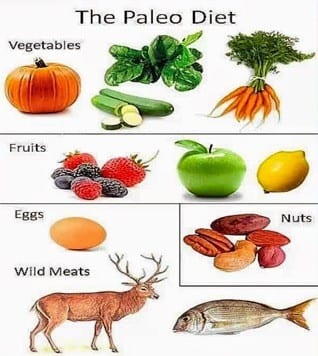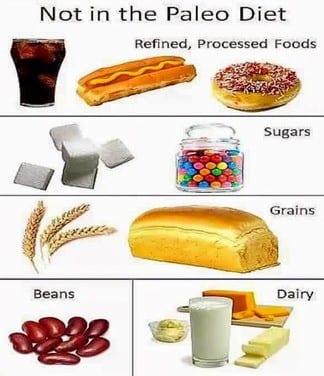The Paleo Diet Definition
Blue indicates link
The Paleolithic diet, Paleo diet, caveman diet, or stone-age diet is a modern fad diet requiring the sole or predominant eating of foods presumed to have been available to humans during the Paleolithic era.
The digestive abilities of anatomically modern humans, however, are different from those of pre-Homo sapiens humans, which has been used to criticize the diet’s core premise. During the 2.6 million year-long Paleolithic eras, the highly variable climate and worldwide spread of human populations meant that humans were, by necessity, nutritionally adaptable. Supporters of the diet mistakenly assume that human digestion has remained essentially unchanged over time.
While there is wide variability in the way the paleo diet is interpreted, the diet typically includes vegetables, fruits, nuts, roots, and meat and typically excludes foods such as dairy products, grains, sugar, legumes, processed oils, salt, alcohol, and coffee. The diet is based on avoiding not just processed foods, but rather the foods that humans began eating after the Neolithic Revolution when humans transitioned from hunter-gatherer lifestyles to settled agriculture. The ideas behind the diet can be traced to Walter L. Voegtlin during the 1970s. In the 21st century, the paleo diet was popularized in the best-selling books of Loren Cordain.
The paleo diet is promoted as a way of improving health. There is some evidence that following this diet may lead to improvements in terms of body composition and metabolic effects compared with the typical Western diet or compared with diets recommended by national nutritional guidelines. Following the paleo diet can lead to nutritional deficiencies such as inadequate calcium intake, and side effects can include weakness, diarrhea, and headaches
Eat like a caveman and shed pounds. That’s the theory behind the Paleo Diet.
Loren Cordain, Ph.D., who literally wrote the book on The Paleo Diet, claims that by eating like our prehistoric ancestors, we’ll be leaner and less likely to get diabetes, heart disease, cancer, and other health problems.
Also called the Caveman Diet or the Stone Age diet, it’s basically a high-protein, high-fiber eating plan that promises you can lose weight without cutting calories.
Ultimate Paleo Diet Video
What does the Paleo diet consist of?
The aim of a paleo diet is to return to a way of eating that’s more like what early humans ate. The diet’s reasoning is that the human body is genetically mismatched to the modern diet that emerged with farming practices — an idea known as the discordance hypothesis.
Farming changed what people ate and established dairy, grains, and legumes as additional staples in the human diet. This relatively late and rapid change in diet, according to the hypothesis, outpaced the body’s ability to adapt. This mismatch is believed to be a contributing factor to the prevalence of obesity, diabetes, and heart disease today.
Why you might follow a paleo diet
You might choose to follow a paleo diet because of you:
- Want to lose weight or maintain a healthy weight
- Want help planning meals
Details of a paleo diet

Recommendations vary among commercial paleo diets, and some diet plans have stricter guidelines than others. In general, paleo diets follow these guidelines.
What You Can Eat
-
- Fruits
- Vegetables
- Nuts and seeds
- Lean meats, especially grass-fed animals or wild game
- Fish, especially those rich in omega-3 fatty acids, such as salmon, mackerel, and albacore tuna
- Oils from fruits and nuts, such as olive oil or walnut oil
Go Paleo, and you’ll eat a lot of fresh lean meats and fish, fruits, and vegetables, and healthier fats.
You can also eat:
-
- Eggs
- Healthier oils, including olive oil and coconut oil
What to avoid

-
- Grains, such as wheat, oats, and barley
- Legumes, such as beans, lentils, peanuts and peas
- Dairy products
- Refined sugar
- Salt
- Potatoes
- Highly processed foods in general
- Refined vegetable oils, such as canola
You can’t eat any processed foods on this diet. And since our ancestors were hunter-gatherers, not farmers, say goodbye to wheat and dairy, along with other grains and legumes (such as peanuts and beans). Other foods to avoid:
Results
A number of randomized clinical trials have compared the paleo diet to other eating plans, such as the Mediterranean Diet or the Diabetes Diet. Overall, these trials suggest that a paleo diet may provide some benefits when compared with diets of fruits, vegetables, lean meats, whole grains, legumes, and low-fat dairy products. These benefits may include:
- More weight loss
- Improved glucose tolerance
- Better blood pressure control
- Lower triglycerides
- Better appetite management
However, longer trials with large groups of people randomly assigned to different diets are needed to understand the long-term, overall health benefits and possible risks of a paleo diet.
A typical day’s menu
Here’s a look at what you might eat during a typical day following a paleo diet:
- Breakfast. Broiled salmon and cantaloupe.
- Lunch. Broiled lean pork loin and salad (romaine, carrot, cucumber, tomatoes, walnuts, and lemon juice dressing).
- Dinner. Lean beef sirloin tip roast, steamed broccoli, salad (mixed greens, tomatoes, avocado, onions, almonds, and lemon juice dressing), and strawberries for dessert.
- Snacks. An orange, carrot sticks, or celery sticks.
The diet also emphasizes drinking water and being physically active every day.
Dietary concerns


A paleo diet is rich in vegetables, fruits, and nuts — all elements of a healthy diet.
The primary difference between the paleo diet and other healthy diets is the absence of whole grains and legumes, which are considered good sources of fiber, vitamins, and other nutrients. Absent from the diet are dairy products, which are good sources of protein and calcium.
These foods not only are considered healthy but also are generally more affordable and accessible than such foods as wild game, grass-fed animals, and nuts. For some people, a paleo diet may be too expensive.
Does It Work?
Eliminating all grains, dairy, processed foods, sugar, and more will most likely lead to weight loss, but it may be a tough plan to follow long-term due to the dietary limitations and restrictions.
There are several studies on certain aspects of the Paleo Diet. While they may not support all the claims made in the book, they have found that a diet rich in lean protein and plant-based foods can make you feel fuller, help control blood sugar levels, and help you lose weight.
Eliminating salt and processed foods makes this low-sodium diet good for people with high blood pressure.
Check with your doctor before starting on this plan.
Is It Good for Certain Conditions?
The author claims there are clinical trials that show a paleo diet can lower the risk of heart disease, blood pressure, and inflammation, plus lose weight, reduce acne, and promote optimum health and athletic performance. But many experts are not so sure and more research is needed.
Conclusion about the paleo diet.
A paleo diet may help you lose weight or maintain your weight. It may also have other beneficial health effects. However, there are no long-term clinical studies about the benefits and potential risks of the diet.
You might be able to achieve the same health benefits by getting enough exercise and eating a balanced, healthy diet with a lot of fruits and vegetables.
Paleo Diet Recipies:
Images of Paleo Diet Recipies. Please click.
Thank you for reading,
Michael.
Comments are welcome
Wow, I’ve been hearing about this Paleo Diet before and even considered starting a website around this topic but it is only now that I have fully understood what does Paleo Diet mean. So, thank you so much and I find your explanation and your recommendations very helpful in my research.
I believe, the cave men during those Paleo period existed almost at the same time those personalities mentioned in the Bible also lived. They have lived the longest lives with some of them reaching up to 900 years of age. So, with that, I truly believe in the longevity-giving power of a Paleo Diet and I myself must adapt to this kind of diet to stay healthy and live longer.
Hi Gomer,
Thank you for your comments. Seems like the Paleo diet is a nice clean way of eating. I also did an article on the Keto diet, to see which one came ahead.
Best wishes,
Michael
I have a few expeirence with the paleo deit althoug i havent gone of this diet before but i have a host of persons who have so i have had the opportunity to try out some of their foods and i must sey they have some very nice food types undermining certain restrictins to some foods….
Hi David,
Thank you for your comments.
Best wishes,
Michael